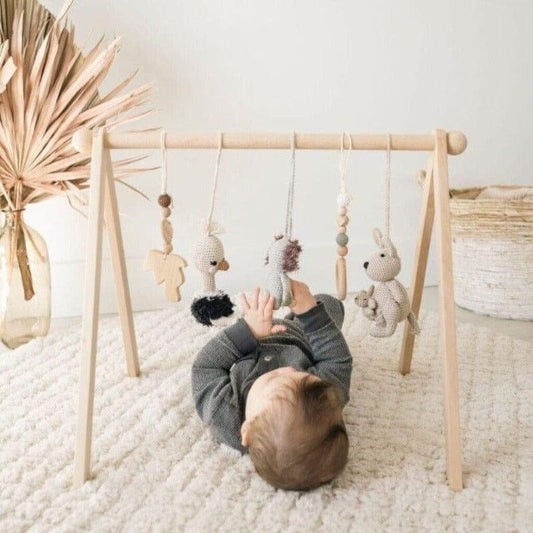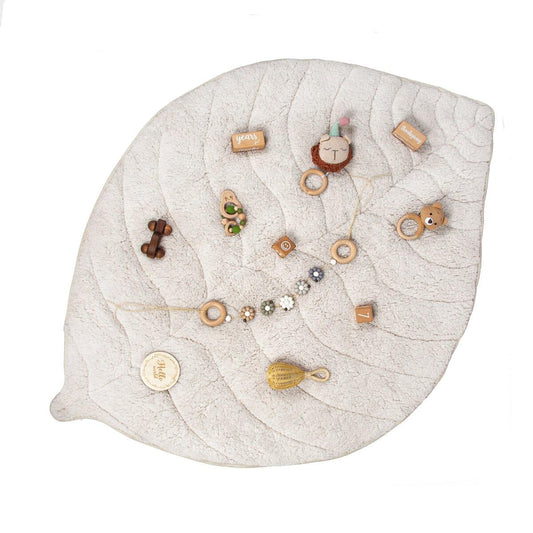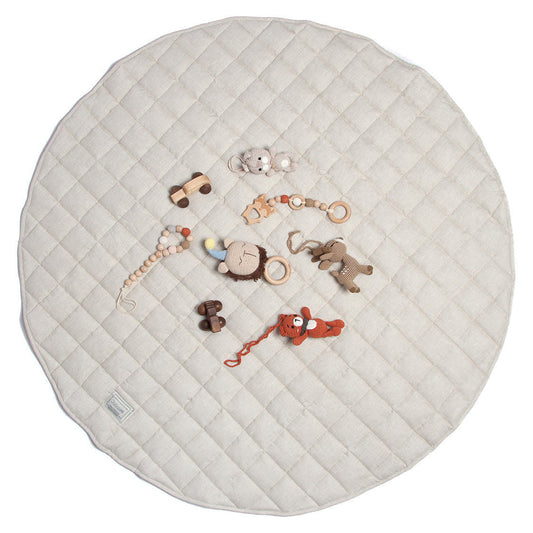Article Information:
Updated:
Excerpt:

You may also like:
8 Enjoyable Indoor Activities for Your Energetic Toddler
Looking for some fun indoor activities to keep your toddler entertained? Check out our list of 8 enjoyable indoor activities that will help burn off some of that extra energy!
6 Tips for Safely Trimming Your Toddler's Nails
If you're like most parents, the thought of trimming your toddler's nails probably fills you with a bit of dread. But it doesn't have to be a scary experience! Here are six tips for safely trimming your toddler's nails.
Experts Recommend Adopting This Habit When Communicating with Your Toddler
Experts recommend adopting this habit when communicating with your toddler to help them feel more comfortable and improve their language skills.
3 Steps to Establishing Toddler Boundaries with Empathy
It can be tough to establish boundaries with a toddler, but it's important to do so with empathy. Here are three steps to help you get started.
3 Subtle Indicators of Your Toddler's Developing Language Skills
It can be tricky to know whether your toddler is on track with their language development. However, there are some subtle indicators that can give you a clue. Here are three of them.
The Timeless Appeal of Pull Toys
There's something special about pull toys. They've been around for centuries, and yet they still hold a place in the hearts of children and adults alike. Maybe it's the simplicity of their design, or the way they encourage movement and play. Whatever the reason, pull toys are timeless classics that will never go out of style.
How to Establish a Bedtime Routine That Helps Your Toddler Sleep Better
A bedtime routine is key in helping your toddler sleep through the night. This guide will help you establish a bedtime routine that includes a bath, story time, and cuddling.
Say Goodbye to Night Lights: 4 Tips for Longer Toddler Sleep
Parents know the drill: the second you turn off the night light, your toddler is awake and screaming. But it doesn't have to be this way. Here are four tips to help your toddler sleep through the night.
Recognizing Patterns: Preparing Your Toddler's Brain for Mathematics
Recognizing patterns is an important skill for preparing your toddler's brain for mathematics. By playing games and engaging in activities that encourage pattern recognition, you can help your child develop the foundation they need for success in math.
Benefits of 'Crib Talk' for Toddlers
Crib talk is a great way for toddlers to learn new words and improve their communication skills. Here are some of the benefits of crib talk for toddlers.
Benefits of 'Crib Talk' for Toddlers
Crib Talk is the secret language of toddlers that can bring many development benefits. It's a creative and authentic way for young children to express their thoughts, feelings and needs. When parents engage in Crib Talk with their toddlers it shows support and provides an environment to foster open communication and emotional connection.
Crib Talk also helps cognitive development. Through this imaginative language, toddlers exercise problem-solving skills and creativity. It gives them a sense of autonomy and independence, and encourages self-confidence and self-expression.
The benefits extend beyond just the parent-child relationship. Interacting with others who understand Crib Talk helps develop social skills such as empathy and cooperation. It creates a sense of belonging in the toddler community, and prepares them for healthy relationships later in life.
For the full rewards of Crib Talk, it's important for parents to embrace it. Participating in conversations with their toddlers shows love and support. So dive into the magical world of Crib Talk for precious moments of connection with your child!
Benefits of Crib Talk for Toddlers
Crib talk is a special way to engage toddlers with many benefits. It helps them develop language and communication skills, boosts cognitive abilities, and encourages social interaction between parents and their little ones.
Research from the Center for Early Learning at the University of Virginia found that regular crib talk can have lasting effects. Kids who take part in this activity exhibit better language and cognitive skills later on in life.
Here are some tips to make the most of crib talk:
- Initiate conversations with your toddler.
- Introduce new words and reinforce sentence structures.
- Encourage them to talk about their experiences.
- Listen and respond enthusiastically.
Make sure to enjoy every moment of crib talk – you never know what cute stories you might hear about naptime!
Tips for Using Crib Talk Effectively
Crib talk is key for toddlers' development. Here are a few tips to maximize its effects:
- Create a comforting space: Make sure the crib is cozy and comfortable. Use soft bedding, dim lighting, and calming music.
- Talk gently and reassuringly: Speak softly and lovingly to your child. This will make them feel safe and loved.
- Establish bedtime routines: Having a regular pattern of activities before bed can improve crib talk. Think reading stories or singing lullabies.
- Be present: Give your undivided attention to your kid. No phones or devices allowed!
Other ideas to consider:
- Teach self-soothing techniques: Show your toddler age-appropriate methods. For example, hugging a soft toy or taking deep breaths.
- Use visual aids: Picture books or soft toys can make the experience more interactive.
- Practice active listening: Listen to your child and reflect back on what they say. Validate their feelings and ask open-ended questions. This supports their language development.
By using these tips, you create an environment that nurtures emotional connection, language development, and security. Crib talk is a powerful tool to support their growth and wellbeing. So, remember: a well-timed babble can be the first step towards a future TED Talk!
Conclusion: Emphasizing the Importance of Crib Talk for Toddlers' Development
Crib talk, or baby babble, is vital for toddlers. It lays the groundwork for language and communication. When babies babble, they make sounds and try out different vocalizations. This helps them comprehend the link between their actions and the responses they get from caregivers.
Crib talk isn't just random noise; it's a big step towards language learning. Babies imitate sounds like their parents' voices or household noises. This helps them spot patterns and comprehend how communication works.
Crib talk also bolsters cognitive development in toddlers by pushing exploration and problem-solving. Babies babble as they observe their environments and tinker with things nearby. This engages their hand-eye coordination and sparks their curiosity.
A great example of the power of crib talk is the story of Emily. At eight months old, Emily would babble away in her crib. Her parents found it amusing, but soon realized it was more than that.
One day, Emily's favorite stuffed animal fell out of reach. Instead of crying for help, she spoke a string of syllables at it. To her joy - and her parents' astonishment - the stuffed animal seemed to inch closer to her.
This incident showed Emily's growing ability to communicate through crib talk. By using her voice purposefully and connecting cause-and-effect, she could solve a problem on her own.
Frequently Asked Questions
1. What is Crib Talk and how does it benefit toddlers?
Crib Talk is a communication method where parents engage in conversation with their toddlers before sleep. It offers several benefits, including enhancing language development, improving cognitive skills, and fostering parent-child bonding.
2. At what age should I start using Crib Talk with my toddler?
Crib Talk can be introduced when your toddler is around 6-9 months old and starting to respond to sound and communication. It is never too early to begin engaging in this interactive conversation with your child.
3. What are the specific language development benefits of Crib Talk?
Through Crib Talk, toddlers are exposed to a wide range of words, sentence structures, and vocabulary. This helps improve their language skills, expands their vocabulary, and enhances their ability to express themselves verbally.
4. Can Crib Talk help with my toddler's cognitive development?
Yes, engaging in Crib Talk stimulates a toddler’s brain and encourages cognitive development. The interactive conversation promotes critical thinking, problem-solving, and early literacy skills, setting a strong foundation for future learning.
5. How does Crib Talk contribute to parent-child bonding?
Crib Talk provides a dedicated and intimate time for parents to connect with their toddlers. This bonding opportunity strengthens the parent-child relationship, fosters trust, and creates a sense of security and emotional well-being for the child.
6. Is Crib Talk suitable for all toddlers?
Yes, Crib Talk is suitable for all toddlers as it can be tailored to their individual developmental stages and abilities. It adapts to the child's current communication skills, gradually advancing their language and cognitive capabilities.
Benefits of 'Crib Talk' for Toddlers
Updated:

Crib Talk is the secret language of toddlers that can bring many development benefits. It's a creative and authentic way for young children to express their thoughts, feelings and needs. When parents engage in Crib Talk with their toddlers it shows support and provides an environment to foster open communication and emotional connection.
Crib Talk also helps cognitive development. Through this imaginative language, toddlers exercise problem-solving skills and creativity. It gives them a sense of autonomy and independence, and encourages self-confidence and self-expression.
The benefits extend beyond just the parent-child relationship. Interacting with others who understand Crib Talk helps develop social skills such as empathy and cooperation. It creates a sense of belonging in the toddler community, and prepares them for healthy relationships later in life.
For the full rewards of Crib Talk, it's important for parents to embrace it. Participating in conversations with their toddlers shows love and support. So dive into the magical world of Crib Talk for precious moments of connection with your child!
Benefits of Crib Talk for Toddlers
Crib talk is a special way to engage toddlers with many benefits. It helps them develop language and communication skills, boosts cognitive abilities, and encourages social interaction between parents and their little ones.
Research from the Center for Early Learning at the University of Virginia found that regular crib talk can have lasting effects. Kids who take part in this activity exhibit better language and cognitive skills later on in life.
Here are some tips to make the most of crib talk:
- Initiate conversations with your toddler.
- Introduce new words and reinforce sentence structures.
- Encourage them to talk about their experiences.
- Listen and respond enthusiastically.
Make sure to enjoy every moment of crib talk – you never know what cute stories you might hear about naptime!
Tips for Using Crib Talk Effectively
Crib talk is key for toddlers' development. Here are a few tips to maximize its effects:
- Create a comforting space: Make sure the crib is cozy and comfortable. Use soft bedding, dim lighting, and calming music.
- Talk gently and reassuringly: Speak softly and lovingly to your child. This will make them feel safe and loved.
- Establish bedtime routines: Having a regular pattern of activities before bed can improve crib talk. Think reading stories or singing lullabies.
- Be present: Give your undivided attention to your kid. No phones or devices allowed!
Other ideas to consider:
- Teach self-soothing techniques: Show your toddler age-appropriate methods. For example, hugging a soft toy or taking deep breaths.
- Use visual aids: Picture books or soft toys can make the experience more interactive.
- Practice active listening: Listen to your child and reflect back on what they say. Validate their feelings and ask open-ended questions. This supports their language development.
By using these tips, you create an environment that nurtures emotional connection, language development, and security. Crib talk is a powerful tool to support their growth and wellbeing. So, remember: a well-timed babble can be the first step towards a future TED Talk!
Conclusion: Emphasizing the Importance of Crib Talk for Toddlers' Development
Crib talk, or baby babble, is vital for toddlers. It lays the groundwork for language and communication. When babies babble, they make sounds and try out different vocalizations. This helps them comprehend the link between their actions and the responses they get from caregivers.
Crib talk isn't just random noise; it's a big step towards language learning. Babies imitate sounds like their parents' voices or household noises. This helps them spot patterns and comprehend how communication works.
Crib talk also bolsters cognitive development in toddlers by pushing exploration and problem-solving. Babies babble as they observe their environments and tinker with things nearby. This engages their hand-eye coordination and sparks their curiosity.
A great example of the power of crib talk is the story of Emily. At eight months old, Emily would babble away in her crib. Her parents found it amusing, but soon realized it was more than that.
One day, Emily's favorite stuffed animal fell out of reach. Instead of crying for help, she spoke a string of syllables at it. To her joy - and her parents' astonishment - the stuffed animal seemed to inch closer to her.
This incident showed Emily's growing ability to communicate through crib talk. By using her voice purposefully and connecting cause-and-effect, she could solve a problem on her own.
Frequently Asked Questions
1. What is Crib Talk and how does it benefit toddlers?
Crib Talk is a communication method where parents engage in conversation with their toddlers before sleep. It offers several benefits, including enhancing language development, improving cognitive skills, and fostering parent-child bonding.
2. At what age should I start using Crib Talk with my toddler?
Crib Talk can be introduced when your toddler is around 6-9 months old and starting to respond to sound and communication. It is never too early to begin engaging in this interactive conversation with your child.
3. What are the specific language development benefits of Crib Talk?
Through Crib Talk, toddlers are exposed to a wide range of words, sentence structures, and vocabulary. This helps improve their language skills, expands their vocabulary, and enhances their ability to express themselves verbally.
4. Can Crib Talk help with my toddler's cognitive development?
Yes, engaging in Crib Talk stimulates a toddler’s brain and encourages cognitive development. The interactive conversation promotes critical thinking, problem-solving, and early literacy skills, setting a strong foundation for future learning.
5. How does Crib Talk contribute to parent-child bonding?
Crib Talk provides a dedicated and intimate time for parents to connect with their toddlers. This bonding opportunity strengthens the parent-child relationship, fosters trust, and creates a sense of security and emotional well-being for the child.
6. Is Crib Talk suitable for all toddlers?
Yes, Crib Talk is suitable for all toddlers as it can be tailored to their individual developmental stages and abilities. It adapts to the child's current communication skills, gradually advancing their language and cognitive capabilities.
You may also like:
8 Enjoyable Indoor Activities for Your Energetic Toddler
Looking for some fun indoor activities to keep your toddler entertained? Check out our list of 8 enjoyable indoor activities that will help burn off some of that extra energy!
6 Tips for Safely Trimming Your Toddler's Nails
If you're like most parents, the thought of trimming your toddler's nails probably fills you with a bit of dread. But it doesn't have to be a scary experience! Here are six tips for safely trimming your toddler's nails.
Experts Recommend Adopting This Habit When Communicating with Your Toddler
Experts recommend adopting this habit when communicating with your toddler to help them feel more comfortable and improve their language skills.
3 Steps to Establishing Toddler Boundaries with Empathy
It can be tough to establish boundaries with a toddler, but it's important to do so with empathy. Here are three steps to help you get started.
3 Subtle Indicators of Your Toddler's Developing Language Skills
It can be tricky to know whether your toddler is on track with their language development. However, there are some subtle indicators that can give you a clue. Here are three of them.
The Timeless Appeal of Pull Toys
There's something special about pull toys. They've been around for centuries, and yet they still hold a place in the hearts of children and adults alike. Maybe it's the simplicity of their design, or the way they encourage movement and play. Whatever the reason, pull toys are timeless classics that will never go out of style.
How to Establish a Bedtime Routine That Helps Your Toddler Sleep Better
A bedtime routine is key in helping your toddler sleep through the night. This guide will help you establish a bedtime routine that includes a bath, story time, and cuddling.
Say Goodbye to Night Lights: 4 Tips for Longer Toddler Sleep
Parents know the drill: the second you turn off the night light, your toddler is awake and screaming. But it doesn't have to be this way. Here are four tips to help your toddler sleep through the night.
Recognizing Patterns: Preparing Your Toddler's Brain for Mathematics
Recognizing patterns is an important skill for preparing your toddler's brain for mathematics. By playing games and engaging in activities that encourage pattern recognition, you can help your child develop the foundation they need for success in math.
Benefits of 'Crib Talk' for Toddlers
Crib talk is a great way for toddlers to learn new words and improve their communication skills. Here are some of the benefits of crib talk for toddlers.
-
Baby Activity Gym & Crochet Toys
Rated 4.8 out of 5$139.00$149.00$139.00Sale -
Leaf Shaped Sherpa & Cotton Baby Playmat - Pearl
Rated 4.9 out of 5$69.00$89.00$69.00Sale -
-
Sherpa & Cotton Baby Playmat - Pearl Sherpa
Rated 4.8 out of 5$89.00$99.00$89.00Sold out



